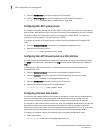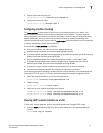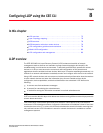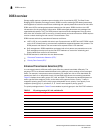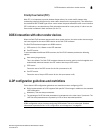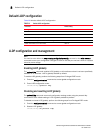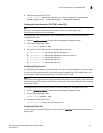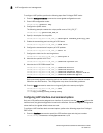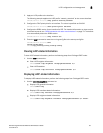
78 Dell Converged Enhanced Ethernet Administrator’s Guide
53-1002116-01
DCBX overview
8
DCBX overview
Storage traffic requires a lossless communication which is provided by CEE. The Data Center
Bridging (DCB) Capability Exchange Protocol (DCBX) is used to exchange CEE-related parameters
with neighbors to achieve more efficient scheduling and a priority-based flow control for link traffic.
DCBX uses LLDP to exchange parameters between two link peers; DCBX is built on the LLDP
infrastructure for the exchange of information. DCBX-exchanged parameters are packaged into
organizationally specific TLVs. The DCBX protocol requires an acknowledgement from the other
side of the link, therefore LLDP is turned on in both transmit and receive directions. DCBX requires
version number checking for both control TLVs and feature TLVs.
DCBX interacts with other protocols and features as follows:
• LLDP—LLDP is run in parallel with other Layer 2 protocols such as RSTP and LACP. DCBX is built
on the LLDP infrastructure to communicate capabilities supported between link partners. The
DCBX protocol and feature TLVs are treated as a superset of the LLDP standard.
• QoS management—DCBX capabilities exchanged with a link partner are passed down to the
QoS management entity to set up the Dell FCoE hardware to control the scheduling and
priority-based flow control in the hardware.
The DCBX standard is subdivided into two features sets:
• “Enhanced Transmission Selection (ETS)”
• “Priority Flow Control (PFC)”
Enhanced Transmission Selection (ETS)
In a converged network, different traffic types affect the network bandwidth differently. The
purpose of ETS is to allocate bandwidth based on the different priority settings of the converged
traffic. For example, Inter-process communications (IPC) traffic can use as much bandwidth as
needed and there is no bandwidth check; LAN and SAN traffic share the remaining bandwidth.
Table 13 displays three traffic groups: IPC, LAN, and SAN. ETS allocates the bandwidth based on
traffic type and also assigns a priority to the three traffic types as follows: Priority 7 traffic is
mapped to priority group 0 which does not get a bandwidth check, priority 2 and priority 3 are
mapped to priority group 1, priorities 6, 5, 4, 1 and 0 are mapped to priority group 2.
The priority settings shown in Table 13 are translated to priority groups in the Dell FCoE hardware.
TABLE 13 ETS priority grouping of IPC, LAN, and SAN traffic
Priority Priority group Bandwidth check
70 No
62 Yes
52 Yes
42 Yes
31 Yes
21 Yes
12 Yes
02 Yes



